| Search
Places to stay in
|
De old Drift Guest farm
Addo Eastern Cape - South Africa
COME AND RELAX IN OUR TRANQUIL ENVIRONMENT, WITH ONLY SOUNDS OF NATURE AT YOUR DOORSTEP...
Email De old Drift Guest farm Reservations: booksa@madbookings.com
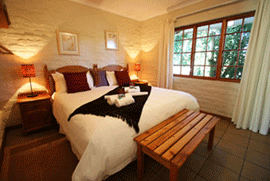 De
Old Drift Guest Farm, a short distance from the little village of Addo
in South Africa’s malaria-free Eastern Cape province and only 15min
drive from the renowned Addo Elephant National Park, with its big Seven,
and numerous other species.
De
Old Drift Guest Farm, a short distance from the little village of Addo
in South Africa’s malaria-free Eastern Cape province and only 15min
drive from the renowned Addo Elephant National Park, with its big Seven,
and numerous other species.
De Old Drift is a working citrus farm, one of the smallest but most peaceful
farms in the area.
Take a tour through the orchards, either by foot or by quad bike and venture
down to The Sundays river, only a short 2km away, where Njala, Kudu’s
and Rooibok can be seen on the ridge of the mountain.
Relax around the pool after a long day at the Elephant Park, or take
a walk through the garden and orchards, when the trees are in blossom,
the smell of citrus permeates the air.
We also have a tea garden thats open during the day where
cappuccino can be served with a variety of freshly baked cakes, we also
do lunches during the day.
Enjoy our refreshing breakfast in our thatched roof lapa overlooking the
garden and swimming pool area.
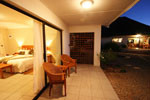

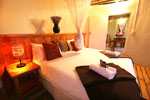
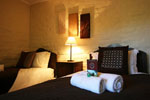
Delano is a qualified tour guide and we do tours in the Addo Elephant
Park on an open top vehicle. ( children from all ages are welcome on our
tours.)
Adventure, fun and games await children, where Pumba (Labrador), Timone
(Jack Russel) and Mufasa (Bullmastiff) love to make new friends and play...
a little paradise for all children. Your hosts Delano & Lize will
make sure that your stay will be one to remember.
De old Drift Guest farm Accommodation
De Old Drift offers a variety of comfortable and spacious furnished rooms.
All our rooms are tastefully furnished with close attention to detail.
Enjoy the peace and quiet on your patio overlooking the garden and mountains
with only the sounds of nature at your doorstep.
The furniture in the rooms has all been crafted by hand and made from
Oregon pine - wood that was salvaged from the original “Drifthouse
Inn”. As you arrive, the welcoming aroma of lavender fills the air,
and butterflies compliment your arrival.
FACILITIES IN ROOM
· Air-conditioning – (heat option)
· Bar fridge
· Tea and coffee tray
· En-suite bathroom (shower only)
· Alarm Clock Radio (for those early morning game drives)
FAMILY UNIT
This unit is ideal for the larger family. It has 2 separate bedrooms a
small lounge area, bathroom with shower, private patio and its own little
rose garden. The perfect getaway, with enough open space where the kids
can play right under your nose.
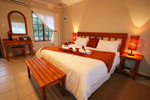
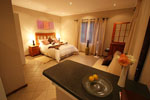
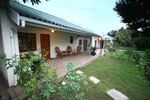

De old Drift Guest farm Facilities
· Air-condition in lounge area – (heating option)
· Bar fridge
· Tea & coffee making facilities
· Separate bathroom (shower only)
· Small lounge area
· Alarm Clock Radio
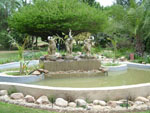
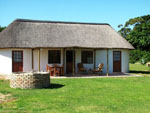
Self catering accommodation:
Thatched Roof Cottage
Our Thatched roof self catering cottage, is very private. Enjoy the views
over the mountain on your private patio while preparing dinner over a
relaxing fire.
This unit has 2 separate bedrooms with open plan living area and a separate
bathroom. The kitchen is fully equipped, includes both, a microwave, and
a conventional oven, as well as all the other necessities to make your
stay as comfortable as possible. (Sleeps 4 people)
Self Catering Unit
Decorated in warm colours and overlooking the lemon orchards, this open
plan unit caters for all. With an easy accessible, fully equipped kitchenette,
separate bathroom with shower and complementing bath, as well as under
cover braai area, makes this unit the perfect self catering getaway. (Sleeps
2 people, has a sleepers couch for children.)
PLEASE NOTE THAT SELF CATERING UNIT & COTTAGE, DO NOT HAVE AIRCONDITIONING.
Activities
Schotia Safaris Schotia is one of the first private
game reserves in South Africa and is situated on the boarder of the Addo
Elephant National Park.
Schotia Safaris offers a four hour guided game drive amongst the lions
and various other wildlife species, in an open top Land Rover, followed
by a delicious buffet dinner which is all prepared on open fires. This
price includes dinner and drinks. Children of all ages are welcome at
Schotia.
Horse Trails – Addo Elephant Park The Addo Elephant National Park offers horse trails for both the beginner as well as the experienced rider, with both morning and afternoon safari’s to choose from. Horseback safaris offer the opportunity to view wild animals in their natural environment but from a safe distance. No children under 10 years are allowed.
Elephant Back Safaris Addo Elephant Back Safaris is
situated within the recently proclaimed Greater Addo Elephant National
Park. Appreciate nature from an elephant’s perspective.
Walking beside these gentle giants will allow you to observe the elephant’s
habits in their natural surroundings. This safari experience is about
learning and becoming familiar with one of Africa’s most stately,
intelligent mammals – the African Elephant.
Walk with the Elephants through the bush, ravines and forest. The walk
is not tenuous and at an enjoyable pace. Then enjoy the thrill of riding
these gentle giants to their favourite waterhole to watch them swim and
make the most of the mud.
Here you will be able to relax and enjoy watching the elephants at the
waterhole. You will take back memories that will stay with you forever.
Daily tours: 08h00 am, 11h00 am and 15h30 pm
These tours include the walk, the ride on the elephant as well as feeding
these giants.
Duration: Approximately 3 hours.
Amakhala Game Reserve Feel the heartbeat and rhythm of Africa as you become part of a Big 5 Safari Adventure on Amakhala Game Reserve. The day safaris starts at 12h00 and ends approximately at 16h00. The safari includes a game drive through the reserve, enjoying all the spectacular views.
Enjoy mouth watering snack platters, in the true African tradition, before departing on a tranquil river cruise. After the river cruise, another game drive awaits through different parts of the reserve, making your way back to Reed Valley. Children 6 years and older welcome.
Casa Mia Health Spa Nestled amongst citrus trees in Addo, on a tranquil bank of the Sundays River Valley, Casa Mia offers various Spa treatments and a range of massages.
Addo Reptile & Raptor Centre The Reptile & Raptor
Centre, located only 10 min from De Old Drift Guest Farm, offers visitors
the opportunity to experience a safe, close encounter, with these majestic
and misunderstood creatures.
The Centre is an Animal Recovery and Rehabilitation Centre for sick and
injured birds of prey and reptiles, both wild and captive bred.
DANIEL CHEETAH BREEDING PROJECT Daniell Cheetah breeding
project was established in May 2001 and started with just three cats.
It has since grown with breeding, purchase and swapping of animals.
The aim of this project is to play part in the conservation of Cheetah’s,
the re-establishment of pure gene lines, as well as educating people to
the importance of conserving this amazing specie.
The cheetah project offers a “once-in-a-lifetime’ experience
where visitors do not only get an interesting, personalized tour, but
actually get to interact with the animals.
Visitors are encouraged to touch the cheetahs and have photographs with
some of them. We believe this opens people’s eyes to the importance
of the Cheetah’s conservation.
Situated on the R75 national road, about 45 min drive from Addo.
History of De Old Drift
Addo Drift is the first convenient natural crossing point on
the Sundays River when travelling inland from the sea, and was used by
wild animals and earlier human inhabitants as a ford. Europeans followed
the same route, outspaning their oxen at a point nearby.
The military post “Ados Drift” appears on the site maps
dated 1815. In 1823 one William Wright, an 1820 settler, was given a grant
of land near the drift. The earliest record of a license being issued
to Zondagh’s River Inn, is the Cape Almanac of 1830.
Samuel Rowe and his wife Sarah arrived in South Africa on the “Belle
Alliance” in 1820. He evidently remained in charge of Addo Drift
Inn for some years. By the time that Edward Turnbridge bought the inn
it was known as the “Elephant and castle”.
Mr. Charles Rowe speculated the origin of the name:
It was not unusual to see elephants drinking on the far side of the Drift.
On one occasion an elephant had slithered down and stuck in the mud.
Having an injured trunk, he was unable to lever himself up again, so he
could only cross to the other side where he stood on the bank.
At that moment Samuel Rowe, innkeeper, returning from some farm festivity,
which probably included good English ale, came face to face with the large
and angry beast.
Sam ran to warn the others. Armed with guns and lead bullets, they sallied
forth for some sport. The elephant remained indifferent to the rain of
lead bullets and only objected to the yapping of Sam’s dog, Sixpence.
Some steel bullets were then made, but by then the elephant had gone
into the bush. Samuel started for home through the bush.
Looking back, he suddenly saw the elephant within a few feet of him. He
fled across the bush and never stopped running until he reached the inn,
with the elephant at his heels
Thomas and Fanny Turnbridge of Alkham, near Dover, had fourteen children.
The second eldest, Edward, born in 1816, was the owner of the Drift Inn.
He visited South Africa in a ship commanded by his friend Captain James
Clarke, and evidently liked the country so much that he returned in 1843.
He was accompanied by his wife and a younger brother Tilden, a sister
Mary who was then married to Captain Clark and their three year old daughter
Fanny, another sister Elize, married to a carpenter Hadlow, also from
Dover.
They are both buried at the Drift. He advertised in 1848 that he had
taken over the “Elephant and Castle,” Sundays River.
He was a carpenter by trade and started a wagon building business and
it was here that the iron was first put on wagon wheels in this country.
The name Elephant and Castle was then dropped and the plan is marked “Turnbridge’s
Hotel.” All the bedrooms bear the names of the Turnbridge family,
living there. After the death of Turnbridge’s wife, he returned
to England leaving his brother and sons to carry on the business.
The old homestead, with its extensive outbuildings, served for many years as an Inn and a defense post. The graveyard near the Inn was in use while the nearest mission was 20 miles away and the nearest church in Port Elizabeth.
Amongst the outbuildings of the Inn was a smallpox station. During 1866
there was a particularly serious outbreak of smallpox and many people
died.
Tilden built a Pont for crossing the river when it was too high to cross
on foot. Tilden became a Justice of the Peace for the district.
The cellar of the inn was often used to house prisoners awaiting trial,
and it is believed that during the wars women and children also sheltered
there. The inn flourished as time went on and coaches’ en-route
from Port Elizabeth to the diamond diggings at Kimberley made their first
night’s stop there.
It is said that two little ghosts in long white frocks and a lady in mauve used to haunt the house.
It seems that the flat let next to the main house was build on the foundations
of the wagon sheds, smithy and married workmen’s quarters.
In the garden there is a huge concrete block, which was used in the past
for to putting the iron on the wagon wheels and for fitting horseshoe’s.
It is now a water feature with elephants called the Elephant and Castle.
AFRICAN FISH EAGLE
The African Fish Eagle is a large bird, and the female is larger than
the male. Males usually have a wingspan of about 2 m (6 feet), while females
have wingspans of more than 2.4 m (8 feet).
They are very distinctive in appearance with a brown body and large, powerful,
black wings. This species is still quite common near freshwater lakes,
reservoirs, or rivers, although they can sometimes be found near the coast
at the mouths of rivers or lagoons.
Breeding season for African Fish Eagles is during the dry season, when
water levels are low. African Fish Eagles are believed to mate for life,
and pairs will often maintain two or more nests, which they will frequently
re-use.
The female lays 1 to 3 eggs, which are primarily white with a few reddish
speckles. Incubation is mostly done by the female, but the male will incubate
when the female leaves to hunt. Incubation lasts for 42 to 45 days before
the chicks hatch.
The African Fish Eagle feeds mainly on fish, which, upon spying it from a perch in a tree, it will swoop down upon and snatch from the water with its large clawed talons and fly back to its perch to eat and will usually begin to venture outside of the nest 2 weeks later.
MALACHITE KINGFISHER
The Malachite Kingfisher (Alcedo cristata) is a river kingfisher which
is widely distributed in Africa south of the Sahara.
It is largely resident except for seasonal climate related movements.
This is a small kingfisher, 13 cm in length. The general colour of the
upper parts of the adult bird is bright metallic blue.
The head has a short crest of black and blue feathers, which gives rise
to the scientific name. The face, cheeks and under parts are rufous and
there are white patches on the throat and rear neck sides.
This is a common species of reeds and rank vegetation near slow moving
water or ponds. The flight of the Malachite Kingfisher is rapid, the short
rounded wings whirring until they appear a mere blur.
It usually flies low over water. The nest is a tunnel in a sandy bank,
usually, though not always, over water. Most burrows incline upward before
the nesting chamber is reached.
There is no nest, but three or four clutches of 3-6 round white eggs are
placed on a litter of fish bones and disgorged pellets.
SPOTTED EAGLE OWL
The Spotted Eagle-owl (Bubo africanus) is a medium-sized species of owl,
one of the smallest of the Eagle owls. Its height is forty-five cm (18
inch) and its weight is from 480 to 850g (1 to 1.8 pounds).
It has a 33cm (13 in) wingspan. The facial disk is off white to pale ochre
and the eyes are yellow. It has prominent ear tufts, and the upper body
is dusky brown, the lower parts off-white with brown bars.
They are nocturnal hunters, spending the day concealed in trees, rock
ledges or abandoned burrows. They are found in areas with rocky outcroppings,
scrub land, open woods, and semi deserts.
Spotted Eagle-owls do not avoid populated areas. They often hunt near
roads and are often struck by vehicles. The major cause of death is pesticides
used in agriculture for insect and rodent control. Spotted Eagle-owls
mate for life. They are able to breed at around one year of age.
They make their nest on the ground and have been known to nest on window
ledges of buildings. Breeding begins in July continuing to the first weeks
of February.
The female lays two to four eggs and does the incubation, leaving the
nest only to eat what the male has brought food. The incubation period
lasts approximately 32 days.
The young owls can fly at around seven weeks of age. Five weeks later,
the young owls leave the nest. They have a life span of up to ten years
in the wild and up to twenty in captivity.
SOUTHERN RED BISHOP
It is 10-11 centimetres long and has a thick conical bill. Breeding males
are brightly-coloured with red and black plumage.
The forehead, face and throat are black and the rest of the head is red.
The upperparts are red apart from the brown wings and tail.
The upper breast and under tail-coverts are red while the lower breast
and belly are black. The non-breeding male and female have streaky brown
plumage, paler below.
Females are smaller than the males. It has various twittering calls
and a nasal contact call. The male has a buzzing song. It occurs from
South Africa north to Angola, southern and eastern parts of Southern Africa.
In the breeding season it is found near water among grass, reeds, sedges
or crops such as sugar cane. Outside the breeding season it will venture
into drier grassland and savanna habitats.
It is a fairly gregarious bird, nesting in colonies and foraging in flocks.
It feeds on seeds and some insects. It often roosts in mixed flocks with
other members of the weaver family.
At the start of the breeding season, the males build several nests to
attract females. They perform a display flight with their feathers fluffed
up. They are polygynous and mate with several females.
The nest is most commonly built among reeds and is made of grasses and
other plant materials woven together. Two to four eggs are laid.
CAPE WEAVER
The Cape Weaver (Ploceus capensis) is a resident breeding bird species
endemic to South Africa. This common species occurs in grassland, agricultural
and fynbos habitats, often near rivers.
It breeds in noisy colonies in trees (often willows or Eucalyptus, rarely
palms) and reed beds. This weaver builds a large coarsely woven nest made
of grass and leaf strips with a downward facing entrance which is suspended
from a branch or reed. The Hadada Ibis will sometimes nest in the weaver
colonies.
The Cape Weaver is a stocky 17 cm long bird with streaked olive-brown
upperparts and a long pointed conical bill. The breeding male has a yellow
head and under parts, an orange face, and a white iris.
The adult female has an olive-yellow head and breast, shading to pale
yellow on the lower belly. Her eyes are brown. Young birds are similar
to the female. The Cape Weaver feeds on a wide variety of seeds, grain
and insects. The calls of this bird include a harsh azwit, azwit.
BLACK HEADED HERON
The Black-headed Heron (Ardea melanocephala) is a wading bird of the heron
family Ardeidae, common throughout much of Africa, south of the Sahara.
It is mainly resident but some West African birds move further north in
the rainy season. This species usually breeds in the wet season in colonies
in trees, reed beds or cliffs.
It builds a bulky stick nest and lays 2–4 eggs. It often feeds in
shallow water, spearing fish or frogs with its long, sharp bill. It will
also hunt well away from water, taking large insects, small mammals and
birds.
It will wait motionless for prey, or slowly stalk its victim. The Black-headed
Heron is a large bird, standing 85 cm tall, and it has a 150 cm wingspan.
It is nearly as large as Grey Heron, which it resembles in appearance,
although it is generally darker. Its plumage is largely grey above, and
paler grey below.
It has a powerful dusky bill. The flight is slow, with its neck retracted.
This is characteristic of herons and bitterns, and distinguishes them
from storks, cranes and spoonbills, which extend their necks. The white
under wing coverts are striking in flight.
CATTLE EGRET
The Cattle Egret (Bubulcus ibis) is a heron native to parts of Asia, Africa
and Europe, which has naturally and successfully colonised much of the
rest of the world.
It is the only member of the monotypic genus Bubulcus, although some authorities
regard its two subspecies as full species.
It is a stocky white bird which has buff plumes in the breeding season.
The breeding habitat of the Cattle Egret is large wetlands in warm countries.
It nests in colonies, often with other wading birds, usually on a platform
of sticks in trees or shrubs.
It feeds in relatively dry grassy habitats, often accompanying cattle or other large mammals, since it catches insects and vertebrate prey disturbed by these animals. Some populations of the Cattle Egret are migratory and others show post-breeding dispersal.
Surrounding Area
The Addo Elephant Park with is big 7 and numerous other species, has guided
game drives during the course of the day, with the most popular being
the sunrise and sundown tours.
The duration of these tours are approximately 2 hours, with the arrival
time being 15 min prior to the game drive. All drives are conducted by
qualified guides in open-top land rovers.
Children under the age of 6 years, are unfortunately, not allowed on these
tours.The times of these guided tours change from season to season.
Email De old Drift Guest farm Reservations: booksa@madbookings.com

 More places to stay in and around Addo
More places to stay in and around Addo